
Research Article
Austin J Clin Ophthalmol. 2018; 5(2): 1090.
Quality of Life of the Patients Followed-up for Primary Open Angle Glaucoma at the National Teaching Hospital of Cotonou-Benin Republic
Odoulami L¹*, Alamou S², Ngouffo H², Tchabi S² and Doutetien C²
¹University Hospital of zone Suru-Léré, Benin
²National Teaching Hospital in Cotonou, Benin
*Corresponding author: Odoulami L, Department of ophthalmology, University of Abomey-Calavi, 03 BP 2915 Cotonou, BENIN
Received: March 15, 2018; Accepted: April 17, 2018; Published: April 24, 2018
Abstract
Purpose: Appreciate the impact of primary open angle glaucoma on the daily lives of patients.
Methods: This is a cross sectional study conducted from June 1st to August 31st 2015, which concerned 52 patients followed-up for primary open angle glaucoma, in which quality of life (QOL) was assessed using a Glaucoma Quality of Life-17 (GlauQol-17)-questionnaire. This latter is composed of 17 items grouped in 7 dimensions.
Results: The average age was of 61.79 years ± 12.22 years and the sex ratio of 0.86. Concerning the dimensions, the average score was 44.08% ± 24.83% for « anxiety », 41.33% ± 23.83% for « self-image », 67.75% ± 29% for « mood », 77.69% ± 23.94% for « daily activities », 58.50% ± 29.63% for « driving », 62.25% ± 26.12% for « constraints » and 62.83% ± 25% for the « self-care ». By order of decreasing frequency, the quality of life (QOL) was influenced by age, the clinical stage of the primary open angle glaucoma, the therapeutic class, the number of eye drops, the marital status, the profession and the visual acuity.
Conclusion: The use of the Glaucoma Quality of Life-17 (GlauQol-17) questionnaire allows the ophthalmologist to evaluate a domain that traditionally escapes him in the doctor-patient relationship.
Keywords: GlauQOL-17; Quality of life (QOL); Primary open angle glaucoma (POAG)
Introduction
The quality of life (QOL) appears as reflecting the impact of disease, treatment and health decisions on the daily life, trying to approach the patient’s point of view [1]. The primary open angle glaucoma (POAG) is an optic neuropathy characterized by its chronicity, its onset is most often insidious, its evolution slowly progressive, with characteristic damage of theoptic nerve and the visual field [2]. Like all chronic diseases, glaucoma has a negative effect on the patient’s lives, an effect that will grow over the years with a gradual evolution towards blindness. More specific of glaucoma, are the dynamic effects of the disease, irreversible and slowly progressive, and often the belated character of the diagnosis, that inflicts to the patients an important psychic suffering. This psychological impact is even less accessible to the clinician that is not directly related to the pathophysiology. Added to this is the burden of a sometime difficult treatment, often cumbersome and not always well tolerated [3]. Therefore appears the necessity for better management of glaucoma patients to appreciate the repercussions of the POAG on their QOL.
Materials and Methods
A cross-sectional study of descriptive and analytical type was conducted over a period of three months (June 1st to August 31st, 2015) at the ophthalmologic department of the National Teaching Hospital in Cotonou.
We included in the study all literate patients aged 18 and above, followed-up for at least 6 months for POAG in Cotonou’s Teaching Hospital and who were received at the consultation during the study period. Were excluded, patients who could not give their illuminated consent.
Were sick of POAG all patients who had presented wide papillary excavations of the two eyes (cup/disc ratio greater than or equal to 0.5) associated to characteristic perimeter deficits of POAG, as well as an open iridocorneal angle according to Shaffer’s classification. Perimeter deficits seen are those of automated visual field surveys of the Octopus 301 according to the G1X program.
We considered three clinical stages of POAG based on perimeter deficits [4]:
- Early glaucoma (EG): bilateral involvement of automated visual field with the most involved eye having a value of Mean Defect (MD) less than 12db in absolute value and perimeter deficits type nasal projection Rönne, enlargement of the blind spot, scotoma of SEIDEL, or scotoma isolated on central para most often between 1 and 10 of the attachment point,
-Moderate glaucoma (MG): bilateral involvement of automated visual field with the most involved eye having a value of MD greater than 12db and less than 20db in absolute and perimeter deficits type arcuate scotoma higher or lower.
- Advanced glaucoma (AG): bilateral involvement of automated visual field with the most involved eye having a value of Mean Defect (MD) greater than 20db absolute and perimeter deficits type ring scotoma with relative preservation of the central region and or the temporal peripheral region, or altitudinal scotoma. QOL was appreciated from GlauQOL-17 questionnaire. This questionnaire contains 17 items grouped in 7 dimensions. The questionnaire was administered and completed with the assistance of the investigator. For each item asked, the participant had a choice of 4 or 5 ordered response categories. Only one answer was allowed per item and each answer brought a number of points for the tested item. Thus, for each dimension, tested summing the points obtained by item was the raw score and the set of the scores permitted to appreciate the participant’s QOL [5].
To facilitate reading scores, these were expressed as percentages and not raw score. The course of study was preceded by the approval of the National Ethics Committee for Research of Benin Health; the study therefore respected the principles of the Helsinki Declaration.
The collected data were processed and analyzed by SPSS 17 and the clearance of the database was made with Epi Info 3.5.3. Pearson Chi² of the test, the test Chi² corrected Yates and Fischer test were used to compare proportions; the association between variables was measured through the Odd Ratio and the significance level adopted was 0.05 percent.
Results
We identified 52 participants whose average age was 61.79 years ± 12.22 years with extremes of 20 and 82 years. Participants under 65 years accounted for 55.8% of the sample. The sex ratio was 0.86, with 24 men (46.15%) and 28 women (53.85%). Half of the participants had a higher education; pensioners and married represented 67.30% of the sample respectively. The distribution of participants by grade level, occupation and marital status are shown in Table 1.
Variable
Modality
Effective
Percentage
School level
Superior
Secondary
Primary
26
24
02
50
46.15
3.85
Profession
Retired
Officials
Trades
Housewife
Students
Others*
35
6
4
3
2
2
67.31
11.54
7.69
5.77
3.85
3.85
Marital status
Married
Widower (widow)
Single
Divorced
35
12
4
1
67.30
23.08
7.69
1.92
Other = temporary teacher and director of an insurance society
Table 1: Distribution of by educational level, occupation and marital status.
A glaucoma family was found in 44.23% of cases. A correction was carried by 47 participants about 90.4%, the average visual acuity correction worn all 96 eyes (47 participants × 2) was equal to 8.6/10th with extremes of 2/10th and 10/10th. The visual acuity from afar with the carried correction was in 82, 98% superior or equal to 7/10th. The mean follow-up was 4.98 ± 3.44 years. As clinical stage of POAG, glaucoma was starting out in 42.31% of cases, moderate in 36.54% and advanced in 21.15% of cases.
On the therapeutic plan, monotherapy was used by 50% of our sample, dual therapy by 34.62% and triple therapy by 15.38%. On the other hand, 67.31% of the patients used only one eye drop, 26.92% of them used 2 eye drops and 15.38% used 3 eye drops.
Analysis of the Dimensions of Quality of Life
Dimension « Anxiety »
The average score of the dimension « Anxiety » was 5.29/12 ± 2.98, or « 44.08% ± 4.83% ». Whatever the clinical stage of POAG, the average scores of « Anxiety » of participants over 65 were higher than those under 65 years (Diagram 1). This dimension was influenced by age, marital status and occupation.

Diagram 1: Average scores for the dimension “Anxiety” depending on age
and clinical stage of POAG.
Dimension « Self-image »
The average score for this dimension was 2.48/1.43 ± 6 or « 41.33% ± 23.83% ».The average scores of the dimension « Self-image » were better in participants over 65years except in cases of advanced POAG (Diagram 2). Clinical stage of POAG and therapeutic class influenced that dimension.
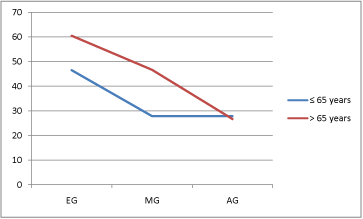
Diagram 2: Average scores for the dimension” self-image” based on age and
clinical stage of POAG.
Dimension « Mood »
For the dimension « Mood », the average score was 5.42/8 ± 2.32 or «67.75% ±29% ». Compared to the participants from more than 65 years, those under 65 had an average score of « Mood » higher if POAG starting; on the contrary, this ratio was reversed with the deterioration of POAG (Diagram 3). Marital status influenced the « Mood ».

Diagram 3: Average scores for the dimension “mood” depending on age and
clinical stage of POAG.
Dimension «Daily activities »
The average of the scores of the dimension « Daily activities » was of 12.43/16 ± 3.83 or « 77.69% ± 23.94% ». The participants under 65 years old had higher average scores of « Daily activities » than those with more than 65 years, whatever is the clinical stage of the POAG (Diagram 4). Age, therapeutic class and visual acuity influenced this dimension.

Diagram 4: Average scores for the dimension “daily activities” depending on
age and clinical stage of POAG.
Dimension « Driving »
The average score of the dimension « Driving » was 4.68/8 ± 2.37, or «58.50% ± 29.63% ». This dimension did not concern 21 patients about 40.38% and 3 patients about 5.77% reported they do not drive at night. The mean scores of « Driving » were generally higher for participants less than 65 years whatever be the clinical stage of the POAG (Diagram 5). Age, clinical stage of POAG and the number of eye drops influenced the dimension« Driving ».
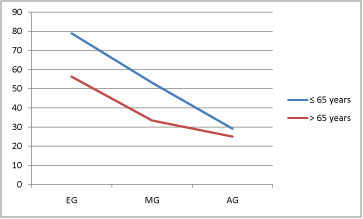
Diagram 5: Average scores for the dimension” Driving” depending on age
and clinical stages of POAG.
Dimension « Constraints »
The average score for this dimension was 4.98/8 ± 2.09 or « 62.25% ± 26.12% ». The younger participants than 65 had average scores of « Constraints » best whatever is the clinical stage of the POAG (Diagram 6). The dimension was influenced by age, the clinical stage of the POAG and the therapeutic class.
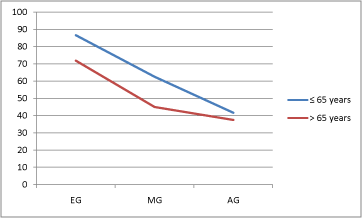
Diagram 6: Average scores for the dimension” constraints” depending on
age and clinical stages of POAG.
Dimension « Self-care »
The average score was 3.77/6 ± 1.5 or « 62.83% ± 25% ». The mean scores of « Self-care » were best for participants under 65 years whatever the clinical stage of the POAG (Diagram 7). This dimension was also influenced by age, the clinical stage of the POAG and the number of eye drops.

Diagram 7: Average scores for the dimension” self-care” depending on age
and clinical stages of POAG.
In summary
- The analysis of the dimensions of QOL allows us to note that, whatever is the patient’s age, the QOL deteriorated with the severity of the GPAO (Diagram 8 and 9).
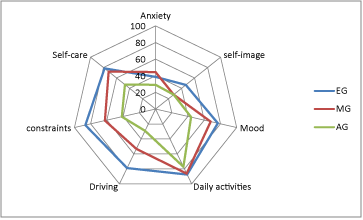
Diagram 8: Average scores quality of life by dimension for the population
under 65 years.
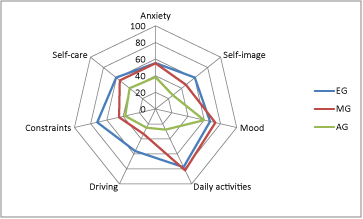
Diagram 9: Average scores quality of life by dimension for the population
over 65 years.
-Except the age of the patient and the clinical stage of the POAG, the QOL was affected by many factors as the marital status, occupation, visual acuity, therapeutic class and the number of eye drops used.
Discussion
Concerning age, Wane and al. [5] in Senegal found a similar average to ours (61.18 ± 10.99 years, with 37.5% aged over 65) in a study on the quality of life in 64 Senegalese older than 40 years and follow-ups for POAG. Ratnani and al. [6] in Morocco and Henia and al. [7] in Tunisia observed a similar mean age. On the contrary, higher average ages were reported by Wolfram and al. [8] in Germany (67 years) and Thygesen and al. [9] in France (70.9 years). The average age lower in African’s series could be explained by life expectancy lower in underdeveloped countries [10].
The female predominance was observed with a sex ratio of 0.86. It is not the rule, because Balkrishnan and al. [11] and Thygesen and al. [9] hada sex ratio of 0.45 and 0.69 respectively, against 1.9 and 1.03 respectively recovered by Wane [5] and Zanlonghi [4].
During this survey, a high frequency of familial glaucoma was discovered; the same conclusion was made by many authors (Merle and al. [12], Agla and al. [13]).
Respectively 42.31%, 36.54% and 21.15% of the participants had an onset of POAG, moderate and advanced; Zanlonghi and al. [4] recovered 36.83%, 32.93% and 30.24% respectively. The reduced frequency of POAG evolved in our series can be explained by the small sample size, the low average age and the less important average length follow-up.
All our participants were treated medically and the monotherapy was the therapeutic diagram the most used. These results are similar to those of Sounouvou [14] to Benin.
Analysis of the Dimensions of Quality of Life
Dimension « Anxiety »
The scores of « Anxiety » were higher for participants over 65 years whatever the clinical stage of POAG (Diagram 1). Zanlonghi and al. [4] in France, assumed that this dimension was assigned to the diagnosis.
Ratnani and al [6] observed a depression and generalized anxiety disorder in respectively 60% and 40% of the participants. For Bogdanici and al. [15], anxiety was associated with ocular hypertension (54%), risk of blindness (74%) and fear of eye surgery (58%). We could deduce that the risk of blindness and the collapse of the visual field truly lead to anxiety.
Dimension « Self-image »
An average score of 88.23% was observed in Senegal [5]. Regarding the mean scores by age and clinical stage of POAG, they varied from 27% to 61%; Zanlonghi and al. [4] discovered larger scores (50 to 75%).
The lowest scores in our survey translate our participants difficulty in sharing their health issues and “the old age that befell them” after the discovery of POAG. According Hamelin et al. [16], half of the patients changed their behavior after the diagnosis.
Dimension « Mood »
Wane and al. [6] obtained a score similar to ours (64.71%). Some participants reported being more discouraged by the cost of care as the disease itself. One might therefore suggest a dimension where items on the cost of the treatment are added.
Dimension « Daily activities »
The scores of this dimension dropped with age and clinical stage of glaucoma (Diagram 4). For Zanlonghi and al. [4], this dimension scores worsened particularly with the deterioration of the visual field.
The average score was 77.69% against 40.07% discovered by Wane and al. [5]. This difference is explained by the higher rate (81.25%) of participants with advanced glaucoma observed by Wane.
Dimension « Driving »
The mean scores decreased with the clinical severity of glaucoma and higher scores were recorded for participants less than 65 years. Zanlonghi and al. [4] reported some records similar to our survey.
A score could not be calculated for 24 of our participants about 46.15%. Of these, 15 were over 65 years and the majority said they could no longer drive for economic reasons or to avoid accidents. According to Wane and al. [5] the « Driving » had concerned only 2 participants on 64. The items of this dimension should therefore be amended to better meet the habits of the peoples of under-developed countries.
Dimension « Constraints »
The scores for the « Constraints » oscillated around 87% at the starting stage of glaucoma, to collapse at about 38% at the advanced stage (Diagram 6). These scores were lower foe the participants of more than 65 years. These results illustrate the difficulty the patients with glaucoma at an advanced stage and the aged patients have in taking their treatment daily and to instill the drops without spilling. According to Zanlonghi and al. [4], this dimension was affected after the diagnosis was announced, but did not change significantly with changes in the visual field deterioration.
Dimension «Self-care »
The scores deteriorated when the clinical stage of the glaucoma worsened with higher scores in participants younger than 65 years (Diagram 7).
Wane and al. [5] observed a mean score of 36.27%. Zanlonghi et al. [4] rather reported that the scores of « Self-care » did not seem more affected at a stage of advanced glaucoma than at the stage of starting glaucoma and that these scores improved after 65 years. This discrepancy could be explained by the fact that patients over 65 years followed-up for a longer period had noticed a relative stability of their glaucoma, concluding the effectiveness of their management.
In summary, the QOL deteriorated with the severity of POAG whatever be the age; the same observation was made by Zanlonghi and al. [4] in France who added that this finding was particularly true for the “Driving” and “Daily activities “.
Conclusion
At the term of our survey, we thereby notice that many domains of life quality of the patients can be altered with the evolution of the glaucomatous disease: by the anxiety and the psychological impact secondary to the announcement of the illness, by the put in place constraining treatment, by the social cover insufficiency and the high cost of the treatment prescribed for life, finally by the degradation of the visual functions and more especially the very penalizing attack of the patient’s visual field. Thus, the use of the GlauQOL-17 questionnaire allows the ophthalmologist to value a domain that escapes him traditionally in the doctor-patient relationship.
References
- Brousse C, Boisaubert B. La qualité de vie et ses mesures. Rev Med Int. 2007; 28: 458–462.
- Denis P, Renard JP, Sellem E. Glaucome section 10 cours de sciences fondamentales et cliniques. In Chapitre 4, glaucome à angle ouvert. Issy-les-Moulineaux (France): Elsevier Masson. 2010; 85-121.
- Arnould B. Qualité de vie. In: Renard JP, Sellem E. Glaucome primitif à angle ouvert. Rapport SFO 2014. Issy-les-Moulineaux (France): Elsevier Masson. 2014; 635-641.
- Zanlonghi X, Robin C, Arnould B, Bresson H, Brouquet Y, Benmedjahed K, et al. Glaucome et qualité de vie. J Fr. Ophtalmol. 2003; 26: 39-44.
- Wane AM, Kane h, Ba ElhadJi A, et al. Qualité de vie de patients mélanodermes atteints de glaucome primitif à angle ouvert selon le traitement. 120e Congrès de la Société Française d’Ophtalmologie, 10-13 mai 2014, Paris (France). Paris: Société Française d’Ophtalmologie; 2014.
- Ratnani K, Benhmidoune L, Ouarrach N, Chakib A, Amraoui A, Berrada S, et al. Impact psychologique, qualité de vie et glaucome. Fr. Ophtalmol. 2007; 30: 308.
- Henia C, Loukil Tabassi F, Mallouch N, Laouini N, Wathek C, Jeddi Blouza A. Corrélation entre déficits périmétriques, morphologie de la papille et qualité de vie chez le patient glaucomateux. J. Fr. Ophtalmol. 2009; 32: 1s-149.
- Wolfram C, Lorenz K, Shlaen R, Verboven Y, Pfeiffer N. Quality of life in ocular hypertension and primary open angle glaucoma. Ophthalmologica. 2013; 229: 227-234.
- Thygesen J, Aagrenb M, Arnavielle S, Bron A, Fro”hlich SJ, Baggesen K, et al. Late-stage, primary open-angle glaucoma in Europe: social and health care maintenance costs and quality of life of patients from 4 countries. Curr Med Res Opin. 2008; 24: 1763–1770.
- Alain Vinet. Travail, organisation et santé: le défi de la productivité dans le respect des personnes. Québec (Canada): Presses Université Laval; 2004.
- Balkrishnan R, Brent Bond J, Byerly WG, Camacho FT, Anderson RT. Medication-related predictors of health-related quality of life in glaucoma patients enrolled in a medicare health maintenance organization. Am J Geriatr Pharmacother. 2003; 1: 75-81.
- Merle H, Renard A, Donnio A, Richer R, Ayeboua L, Ensfelder G, et al. Dépistage du glaucome en Martinique : résultats au sein d’une population de 813 salariés hospitalisés. J Fr Ophtalmol. 2004; 27: 136- 142.
- Agla EK, Balo KP, Agamah AK, Banla M, Koffi-Gué BK. Glaucoma characteristics in 13 families of 2-4 generations. J Fr Ophtalmol. 2003; 26: 169-174.
- Sounouvou I, Tchabi S, Monteiro S, Yehouessi L, Doutetien C, Bassabi SK. Thérapeutique du glaucome primitif à angle ouvert à Cotonou: à propos de 224 cas. J Fr Ophtalmol. 2012; 35: 100-105.
- Bogdanici C, Zavate I, Zavate OP. Quality of life in glaucoma patients. Oftalmologia. 2011; 55: 49-57.
- Hamelin N, Blatrix C, Brion F, Mathieu C, Goemaere I, Nordmann JP. Comment les patients réagissent-ils à la découverte d'un glaucome ?. J Fr Ophtalmol. 2002; 25: 795-798.